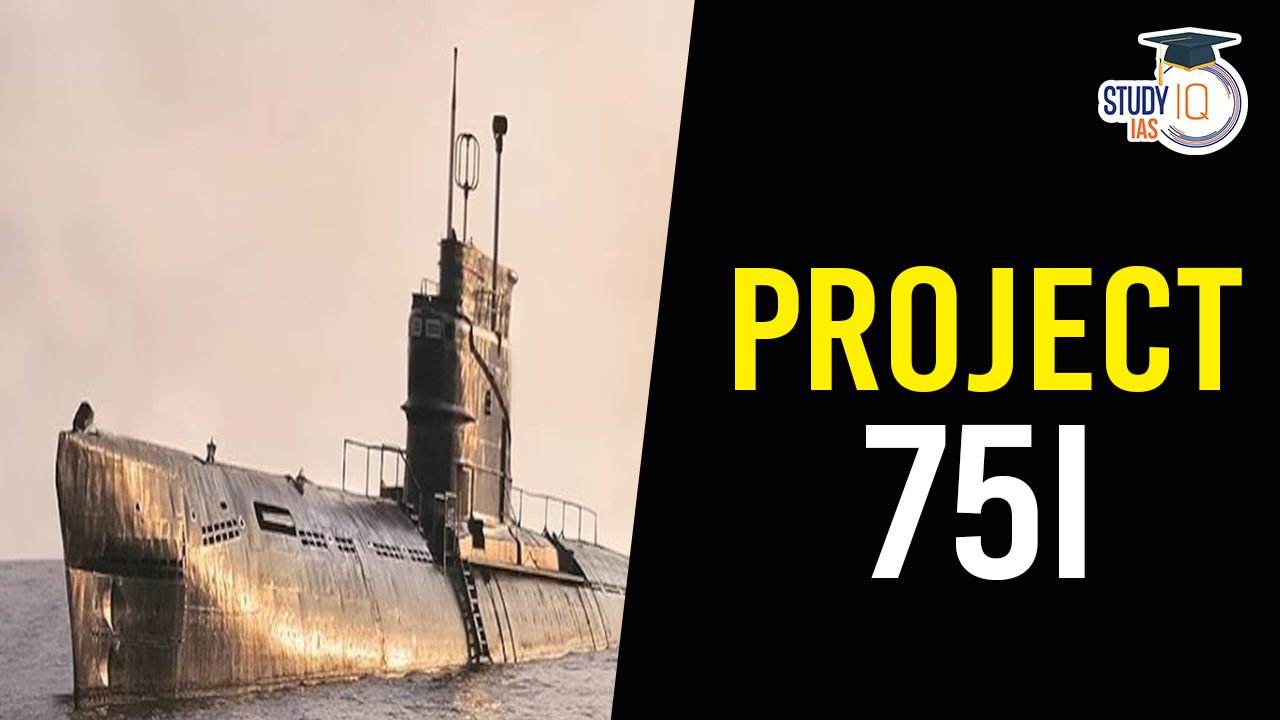Table of Contents
Context
- The German government is considering taking a stake in submarine manufacturer Thyssenkrupp Marine Systems (TKMS).
- This move aligns with TKMS’s interest in increasing shareholder confidence and potentially strengthens India’s position in the Project-75I submarine deal.
About Project-75I
Project-75I is a military acquisition program by India’s Ministry of Defence (MoD) aimed at procuring six advanced diesel-electric submarines with Air Independent Propulsion (AIP) for the Indian Navy.
Background of India’s Submarine Projects Under Project-75I
- Project 75 Initiation:
- Conceived in 1997 for the construction of two indigenous SSK submarines, Type 1500.
- Approved by the Cabinet Committee on Security (CCS) of the Ministry of Defence (MoD).
- Scorpene Submarine Adoption:
- In April 2001, collaboration with Thomson-CSF (TCSF) was discontinued when the Indian Navy chose to adopt the Scorpene design.
- Technology Transfer (TOT) was offered by French naval firm Armaris (now Naval Group).
- Implementation Phases:
- Phase I included constructing some submarines at Mazagon Dock Limited (MDL) under Project 75.
- Phase II aimed at additional submarines built later using indigenous capabilities.
- Financial and Operational Challenges:
- In 1999, the MoD approved a 30-year plan for 24 submarines.
- Financial constraints limited operational status to only six Kalvari-class submarines by the mid-2030s.
- Construction delays were caused by technology adoption challenges, industrial infrastructure issues, and procurement delays.
- Escalation of Costs: The project cost rose from Rs 12,609 crore to Rs 23,562 crore between 2002 and 2010 due to inflation and exchange rate variations.
- Exclusion of Indian Shipyards
- In 2013, the Indian Navy excluded Indian shipyards from Project 75 construction due to delays at MDL.
- MDL, Hindustan Shipyard, L&T, and Pipavav were shortlisted but faced reluctance due to delays in the Scorpene project.
- Strategic Partnership Policy
- Strategic Partnerships in the Defence Sector were finalised as a part of the Defense Procurement Policy (DPP) 2016.
- Foreign firms must now partner with Indian companies for major projects.
- The defence ministry has favoured a proposal to build four Project-75I submarines at Mazagon Dock, Mumbai (MDL), and the remaining two through the designated “strategic partner”.
Project-75I Key Features and Improvements
- Project-75 (India), also known as P-75(I), is a military acquisition initiative by the Ministry of Defence (MoD).
- The initiative aims to procure diesel-electric attack submarines with fuel cells and Air-Independent Propulsion System (AIP) for the Indian Navy to build India’s naval strength and develop indigenous submarine-building capabilities.
- Project 75I succeeded Project 75, under which six Kalvari-class diesel-electric attack submarines, modelled on the Scorpene class, were constructed.
- Six submarines in this project: INS Kalvari, INS Khanderi, INS Karanj, INS Vela, INS Vagir, and INS Vagsheer.
- AIP Technology:
- Allows submarines to stay submerged for up to two weeks without surfacing.
- This greatly enhances their operational capabilities and reduces detection risk.
- Other Features:
- Advanced stealth design, including acoustic absorption.
- Long-range guided torpedoes and anti-ship missiles.
- Sophisticated sonars and sensor suites.
- Cost: In June 2021, the defence ministry issued a tender to build six conventional submarines at about Rs 43,000 crore, making it India’s largest acquisition project.
- TKMS and Spain’s Navantia are the only two bidders in the project.
- Compliance checks and evaluations of both bids are underway, with TKMS passing its field evaluation trials (FET) in March 2024.
- Navantia’s trials are expected to conclude before June.
- TKMS Submarine Design for P-75I:
- TKMS is offering a design based on its successful Class 214 and Class 212CD submarines.
- The proposed submarine will feature an angular design to minimise radar cross-section.
- TKMS’s Indian partner, Mazagon Dock Shipbuilders Limited (MDL), has started the first phase of submarine design.
Emphasis on Indigenization and Benefits
- Gradual Increase: The Request for Proposal (RFP) specifies an initial indigenous content (IC) of 45% in the first submarine, increasing to 60% by the sixth.
- The final design is a joint effort of TKMS and MDL.
- India will own the submarine design, including rights for future integration of indigenous equipment.
- Boost for MSMEs: The project will benefit both core submarine manufacturing and smaller industries supplying parts and equipment (MSMEs).


 Operation Baam: Baloch Separatist Group ...
Operation Baam: Baloch Separatist Group ...
 Genetically Modified Crops in India, Reg...
Genetically Modified Crops in India, Reg...
 National Register of Indian Citizens (NR...
National Register of Indian Citizens (NR...





















